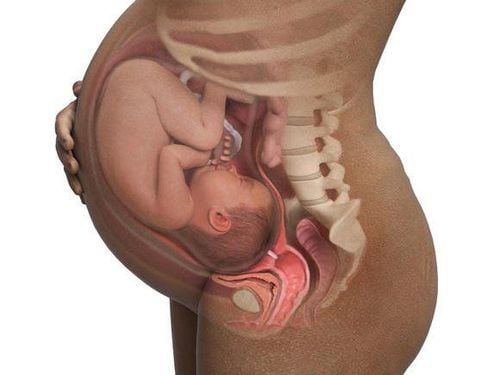This is an automatically translated article.
The article was professionally consulted by Department of Obstetrics and Gynecology, Vinmec Hai Phong International General Hospital.
39 weeks pregnant women begin to feel the pelvic area widening and physiological contractions occur more rapidly. Pregnant women in the last 2 weeks need to determine the position of the fetus to be supported to rotate the baby's head if necessary.
1. What's special about 39 weeks pregnant?
39 weeks pregnant women often feel tired and anxious waiting for the due date. The mother's lower abdomen is distended because the fetus has filled the pelvic area. A pregnant woman's standing posture may have changed more or less because the body's center of gravity is forward.
39 week baby's arms and legs muscles become firmer, toenails and fingernails are almost complete. The head of the fetus has entered the pelvic area and is ready to go with the mother to give birth.
The last 2 weeks of pregnancy need to monitor the body's changes, be alert for the signs of labor, but do not feel too stressed about this. Signs of labor can come as early as 39 weeks pregnant or after another week. False labor contractions are usually more frequent and heavier.

2. How does the 39-week pregnant woman's body change?
39 weeks pregnant women often experience false labor contractions (or Braxton Hicks contractions, physiological contractions). To distinguish from true labor, pregnant women can be based on the following characteristics:
False labor pains are usually concentrated in the lower abdomen and groin, while true labor contractions mostly appear in lower back and may extend to the entire abdomen; Real labor gets heavier over time and doesn't go away when you eat, drink, or change positions.
Trắc nghiệm: Đặc điểm cơn đau đẻ và diễn biến cuộc chuyển dạ
Cơn đau đẻ là dấu hiệu thông báo sự chào đời của em bé. Cùng thử sức với bài trắc nghiệm sau đây sẽ giúp các bà mẹ mang thai nhận biết cơn đau đẻ và diễn biến cuộc chuyển dạ để chuẩn bị trước tâm lý những gì sắp xảy ra đối với mình.The following content is prepared under supervision of Thạc sĩ, Bác sĩ y khoa, Tạ Quốc Bản , Sản phụ khoa , Khoa Sản phụ khoa - Bệnh viện Đa khoa Quốc tế Vinmec Phú Quốc
Another sign of labor is rupture of the amniotic sac. This phenomenon can happen at any time during the 39th week of pregnancy. Pregnant women at this stage who have broken water will see amniotic fluid gushing out in a stream, while some pregnant women feel that the amniotic fluid is less and steady. However, many pregnant women may not have water breaks until labor begins, and in some cases, a doctor may need to stimulate the rupture of the amniotic sac.
Induction of labor is performed when it is necessary for the baby to be born early, especially in cases where the doctor is concerned about the health of the mother and the development of the fetus, or if it is two weeks after the date of birth. due to give birth but the mother still has no signs of labor.
3. Common symptoms in pregnant women at 39 weeks of pregnancy
Braxton Hicks contractions Physiological contractions Braxton Hicks appear more and more heavily, making pregnant women at 39 weeks feel quite uncomfortable, especially those who have been pregnant before.
Fetal movement The space in the womb gradually becomes more cramped due to the stimulation of the already large baby. Therefore, pregnant women in the last 2 weeks usually only feel the slight movements of the fetus, instead of the strong and powerful kicks as in the previous weeks.
Heartburn and indigestion Heartburn during this week of pregnancy is likely to peak. To overcome, pregnant women should drink water before or after meals, limit drinking water while eating.
Vaginal bleeding A pregnant woman's vaginal discharge may be tinged with blood (sometimes pinkish or brownish) due to ruptured blood vessels in the cervix. This is a sign that the cervix of the 39-week pregnant woman is dilating and dilating, preparing for the birth of the baby.
Shedding the cervical mucus plug During pregnancy, the cervical mucus plug helps to protect the amniotic membrane and the fetus in the uterus from the risk of being attacked by bacteria in the vagina. This mucus plug looks like semen or nasal discharge, is transparent or bright red with blood, sometimes brown, thick and sticky. The shedding of the cervical mucus plug is a sign that the baby is about to be born.
Amniotic fluid rupture is one of the emergency signs, indicating that a pregnant mother is about to give birth. The rupture of the amniotic sac is often accompanied by uterine contractions, causing abdominal pain. Each person has different symptoms of rupture of membranes, some people see a large, fast and strong flow of amniotic fluid pouring out of the vagina, sometimes only see a little amniotic fluid. For pregnant women 39 weeks pregnant, the possibility of giving birth within 24 hours after the water breaks is very high.
Diarrhea When a pregnant woman's body gets ready to give birth, the muscles in the rectum can loosen up, leading to loose stools.
Hemorrhoids Fetal pressure on the pelvis can make bowel movements more difficult and can lead to hemorrhoids.
Pelvic pain The baby's head as well as the whole fetus enters the pelvic area, putting a lot of pressure on the muscles and ligaments here, leading to pain.
Back pain Pregnancy back pain can get worse in the last weeks of pregnancy. To overcome back pain, pregnant women at 39 weeks can take a bath with warm water or apply a warm towel to the painful areas.
4. Tips for pregnant women at 39 weeks

4.1. Keep your mood up 39 weeks pregnant is a very sensitive period for pregnancy. However, pregnant women should not be too worried, stressed, affecting their health during this week of pregnancy. Accordingly, pregnant women in the last 2 weeks should focus on rest, moderate light exercise, and most importantly keep the mind comfortable and limit stress.
4.2. Try facials at home One of the ways to help pregnant women feel relaxed while waiting for the baby to "knock on the door" is to take care of their facial skin at home. Spending time massaging your face, applying masks, applying lotion, and steaming your face helps pregnant women feel more confident to welcome the birth of their baby.
4.3. Eating during labor Women who are able to eat and drink during labor usually have a shorter labor time of 45 to 90 minutes. Labor for most pregnant women is considered a difficult and energetic experience. Pregnant women going into labor while hungry can affect the ability to push labor, causing pregnant women to quickly lose strength. In this case, the mother can eat some snacks to give you extra energy and drink water to rehydrate the body.
4.4. Sleep and rest Even sitting all day waiting will not make the signs of labor come sooner. On the other hand, a pregnant woman's body needs rest to stabilize her health. Therefore, pregnant women in the last 2 weeks should focus on sleeping in free time during the day.
4.5. Adjusting the baby's fetal position Pregnant women at 39 weeks need to perform some exercises to support the baby's head rotation, in case the mother's fetus is in the breech position (or inverted position), that is, the fetal bottom is facing the right direction. towards the mother's vulva, the fetal head is located at the bottom of the uterus, towards the mother's chest. The breech will make childbirth difficult. To help your baby turn to the right side, you can do pelvic tilts, kneeling with knees apart, and bending over so your chest touches the ground, three times a day.
39 weeks pregnant women should learn about maternity care packages for the labor stage at reputable hospitals to get the best support from qualified doctors for this extremely important period.
In the last 3 months of pregnancy, the health of both mother and baby needs to be closely monitored and checked. Pregnant women need:
Know the real signs of labor to get to the hospital in time, affecting the health of the fetus. Differentiate between amniotic fluid and vaginal discharge for timely handling to avoid premature birth, fetal distress, and stillbirth. Be especially careful when bleeding in the last 3 months of pregnancy needs urgent emergency care to ensure the life of both mother and baby. Monitor the amount of amniotic fluid regularly and continuously. Monitor fetal weight in the last 3 months to assess baby's development and predict possible risks at birth. The special monitoring group is the same as the striker, and the fetal growth retardation needs to be closely monitored by the doctor and given appropriate indications. Distinguish between physiological contractions, labor contractions and mechanical pregnancy to get to the hospital in time. Maternity services at Vinmec make the pregnancy process easier and safer for pregnant women. During pregnancy, pregnant women will be examined by top doctors in the Obstetrics and Gynecology Department with high professional qualifications and experience, giving the best advice and treatment for the health of both mother and child. little.
For detailed information about all-inclusive maternity service packages, please contact the hospitals and clinics of Vinmec Health system nationwide.
Please dial HOTLINE for more information or register for an appointment HERE. Download MyVinmec app to make appointments faster and to manage your bookings easily.
Reference source: Webmd.com














